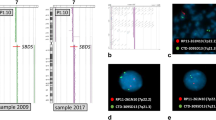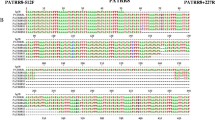Summary
The unusual behaviour of the 9q1 human chromosome region is studied in various conditions. In controls with normal chromosomes 9, del(9q1) is the most frequent spontaneously occurring deletion. This deletion is highly inducible by melphalan, an S phase-dependent alkylating agent. This may correspond to the uncovering of pre-existing DNA breaks in this region. In a 46,XX,9qh+ control, melphalan does not induce deletions any more efficiently than in donors with normal chromosomes 9. In a46,XY,inv(9)(p11q1205) donor, all deletions of inv(9) affect the short, but not the long, arm. This indicates that the sensitive segment is not the whole heterochromatic region, but rather a limited structure. The high rate of rearrangements affecting this structure may be responsible for somatic crossing over, leading to loss of heterozygosity for 9q, and to the frequent occurrence of inv(9) in human populations.
Similar content being viewed by others
References
Al-Achkar W, Sabatier L, Dutrillaux B (1988) Transmission of radiation-induced rearrangements through cell divisions. Mutat Res 198:191–198
Bender MA, Griggs HG, Bedford JS (1974) Mechanisms of chromosomal aberration production. III. Chemicals and ionizing radiations. Mutat Res 23:197–212
Bryant PE (1985) Enzymatic restriction of mammalian cell DNA: evidence for double-strand breaks as potentially lethal lesions. Int J Radiat Biol 48:55–60
Dutrillaux B, Couturier J, Viegas-Pequignot E, Schaison G (1977) Localization of chromatid breaks in Fanconi's anemia, using three consecutive stains. Hum Genet 37:65–71
Dutrillaux B, Viegas-Pequignot E, Prod'Homme M, Sportes M (1985) Distribution of the various radiation-induced chromosomal rearrangements in relation to the dose and sampling time. Mutat Res 152:197–203
Dutrillaux B, Al Achkar W, Aledo R, Aurias A, Couturier J, Dutrillaux AM, Flury-Herard A, Gerbault-Seureau M, Hoffschir F, Lamoliatte E, Lefrancois D, Lombard M, Mamuris Z, Muleris M, Prieur M, Ricoul M, Sabatier L, Viegas-Pequignot E (1987) Isoacentric and isocentric chromosomes originating after deletions of human chromosomes. Hum Genet 76:244–247
Evans HJ, Scott D (1969) The induction of chromosome aberrations by nitrogen mustard and its dependence on DNA synthesis. Proc R Soc Lond B 173:491–512
Human Gene Mapping 10 (1989) 10th International Workshop on Human Gene Mapping. Cytogenet Cell Genet 51:1–1148
Kaina B (1977) The action of N-methyl-N-nitrosourea on non-established human cell lines in vitro. II. Non-random distribution of chromatid aberrations in diploid and Down's cells. Mutat Res 43:401–413
Kucerova M, Polivkova Z (1976) Banding technique used for the detection of chromosomal aberrations induced by radiation and alkylating agents tepa and epichlorohydrin. Mutat Res 34:279–290
Lefrancois D, Al-Achkar W, Aurias A, Couturier J, Dutrillaux AM, Dutrillaux B, Flury-Herard A, Gerbault-Seureau M, Hoffschir F, Lamoliatte E, Lombard M, Muleris M, Prieur M, Ricoul M, Sabatier L, Viegas-Pequignot E (1989) Chromosomal aberrations induced by low-dose γ-irradiation. Study of R-banded chromosomes of human lymphocytes. Mutat Res 212:167–172
Mamuris Z, Gerbault-Seureau M, Prieur M, Pouillart P, Dutrillaux B, Aurias A (1989a) Chromosomal aberrations in lymphocytes of patients treated by melphalan. Int J Cancer 43:80–86
Mamuris Z, Prieur M, Dutrillaux B, Aurias A (1989b) The chemotherapeutic drug melphalan induces breakage of chromosome regions rearranged in secondary leukemia. Cancer Genet Cytogenet 37:65–77
Mamuris Z, Prieur M, Dutrillaux B, Aurias A (1989c) Specific melphalan-induced rearrangements and their transmission through cell divisions. Mutagenesis 4:133–139
Marlhens F, Al Achkar W, Aurias A, Couturier J, Dutrillaux AM, Gerbault-Seureau M, Hoffschir F, Lamoliatte E, Lefrancois D, Lombard M, Muleris M, Prieur M, Prod'Homme M, Sabatier M, Viegas-Pequignot E, Volobouev V, Dutrillaux B (1986) The rate of chromosome breakage is age dependent in lymphocytes of adult controls. Hum Genet 73:290–297
Meyne J, Lockhart LH (1978) Cytogenetic effect of cis-platinum (II) diamminedichloride on human lymphocyte cultures. Mutat Res 58:87–97
Meyne J, Lockhart LH, Arrighi FE (1979) Nonrandom distribution of chromosomal aberrations induced by three chemicals. Mutat Res 63:201–209
Natarajan AT, Zwanenburg TSB (1982) Mechanisms for chromosomal aberrations in mammalian cells. Mutat Res 95:1–6
Prieur M, Al Achkar W, Aurias A, Couturier J, Dutrillaux AM, Dutrillaux B, Flury-Herard A, Gerbault-Seureau M, Hoffschir F, Lamoliatte E, Lefrancois D, Lombard M, Muleris M, Ricoul M, Sabatier L, Viegas-Pequignot E (1988) Acquired chromosome rearrangements in human lymphocytes: effect of aging. Hum Genet 79:147–150
Reeves BR, Margoles C (1974) Preferential location of chlorambucil-induced breakage in the chromosomes of normal human lymphocytes. Mutat Res 26:205–208
Author information
Authors and Affiliations
Rights and permissions
About this article
Cite this article
Mamuris, Z., Aurias, A. & Dutrillaux, B. Identification of a break-prone structure in the 9q1 heterochromatic region. Hum Genet 86, 261–264 (1991). https://doi.org/10.1007/BF00202405
Received:
Issue Date:
DOI: https://doi.org/10.1007/BF00202405




